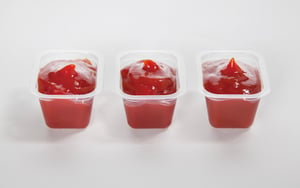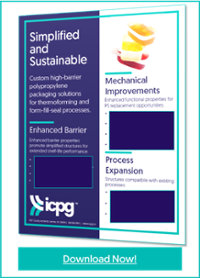 Ketchup and mustard. Peanut butter and jelly. Guacamole and salsa. Condiments, dips and sauces are like icing on the cake that is our meals and snacks - and just like cake and icing combos, everyone has their favorite, and we’re passionate about it. I don’t know about you but my cheeseburger doesn’t taste quite as good without ketchup on top – JUST ketchup.
Ketchup and mustard. Peanut butter and jelly. Guacamole and salsa. Condiments, dips and sauces are like icing on the cake that is our meals and snacks - and just like cake and icing combos, everyone has their favorite, and we’re passionate about it. I don’t know about you but my cheeseburger doesn’t taste quite as good without ketchup on top – JUST ketchup.
With the rise of convenient stores and on-the-go eating, offerings for single serve condiments, dips and sauces as a method of further customizing our food are becoming more expansive, particularly when it comes to snacks. Millennials and other young consumers are gravitating to food products with a dip or spreadable component such as cut veggies and hummus, as opposed to having their food pre-dressed or seasoned, according to QSR Magazine. As with all shelf-stable products, maintaining safety and quality throughout the duration of the products shelf life are key concerns when developing packaging materials for single serve condiments, dips and sauce applications. However, additional safety considerations as a result of Proposition 65 that are effecting material choices for these products, as well as increasing sustainability and recyclability concerns, add additional challenges to the mix.
Continue reading to learn more about some of the key considerations when developing rigid packaging materials for thermoformed single serve condiment packaging and how ICPG can help.
What are the barrier requirements?
Identifying and determining the shelf-life and organoleptic requirements of the product for single serve condiments, dips and sauce applications are essential components of the package development process taking into consideration processing, UV degradation, supply chain, consumer appeal and intended use. Different materials and material structures provide a variety of potential considerations ranging from critical food contact, sealability, taste and odor, shelf-life, top-load, sterilization, filling process and ultimately product food safety. Understanding these elements are key considerations when determining the level and type of barrier required to achieve the optimal shelf-life performance.
One of the primary elements to achieving target shelf life is understanding the required OTR (Oxygen Transmission Rate) and MVTR (Moisture Vapor Transmission Rate) specifications, then developing a material structure with the appropriate barrier characteristics to protect the product throughout its desired shelf-life performance. Development of high performance structures can be achieved through a multi-layer coextrusion process leveraging materials such as EVOH to achieve the required OTR requirements. In addition to the material structure, it is critical to ensure optimal material distribution is achieved to meet the minimum barrier thickness given depth of draw and avoiding sharp angles such as bottom corners during the container design phase.
What is the processing method?
Whether using pre-formed containers or rollstock for form fill and seal applications, understanding the processing methods utilized in condiment packaging directly correlates to material choice and target package performance in order to maximize efficiencies, product safety and ultimately provide a higher level of economic value. Common thermoformed rigid packaging for single serve condiments, dips, sauces syrups and more can be used with processing and sterilization techniques such as retort, hot-fill, HPP and aseptic processing. The packaging and processing method, along with the barrier requirements will play a significant part in determining the best material structure to maintain the safety and integrity of the product.
What is the best material choice?  Today there are more choices than ever when considering the best material for single serve condiment packaging. With increasing industry pressures on sustainability and concerns regarding Proposition 65, ICPG provides material solutions using traditional substrates such as polypropylene, polystyrene and polyethylene with enhanced performance and protection capabilities for direct food contact and extended shelf-life requirements, each with their own set of attributes. Use of materials such as polypropylene, for example, offer better organoleptic properties (taste & odor), high chemical resistance and high heat tolerance allowing for use with various processing and sterilization techniques such as hot-fill, aseptic, and retort processes.
Today there are more choices than ever when considering the best material for single serve condiment packaging. With increasing industry pressures on sustainability and concerns regarding Proposition 65, ICPG provides material solutions using traditional substrates such as polypropylene, polystyrene and polyethylene with enhanced performance and protection capabilities for direct food contact and extended shelf-life requirements, each with their own set of attributes. Use of materials such as polypropylene, for example, offer better organoleptic properties (taste & odor), high chemical resistance and high heat tolerance allowing for use with various processing and sterilization techniques such as hot-fill, aseptic, and retort processes.
The type of packaging and processing method as well as the product’s target shelf-life can affect material structure design. For example, a commercially packaged guacamole would require High Pressure Processing (HPP.) The barrier specifications would determine whether a lower barrier laminated polypropylene or a high-barrier coextruded PP structure with EVOH would offer the best performance. Both structures can be offered in clear and opaque with a variety of additional customization options to enhance brand awareness and packaging differentiation.
Additionally, advancements in cutting-edge barrier technology for specialty polypropylene materials, can allow the right ratio of materials to achieve required barrier performance properties, while allowing for mono-material recycling (i.e. using the resin ID code (RIC) #5 vs RIC #7). Rigid PP products are also recyclable in practice - not just in concept. For several years running, PP has maintained it's spot as one of the top materials recycled and diverted for re-use into other applications in the US, whereas recovery values for other popular alternatives for rigid thermoformed packaging such as PS and PET are lacking.
What is the target shelf life?
As with so many shelf stable products, the single serve condiments, dips and sauces segment are no exception when it comes to defining the optimum shelf life. There is no hard-given rule on what that is, but rather it is dependent on the sterilization process employed to package the product itself in combination with the right barrier structure and conditions throughout the supply chain from processor to consumer.
Feeling inspired to develop customized single serve condiment packaging with ICPG? Click on the link below to download our single-serve condiment packaging solutions info sheet to learn more about the materials, structures and capabilities available for your custom project:




